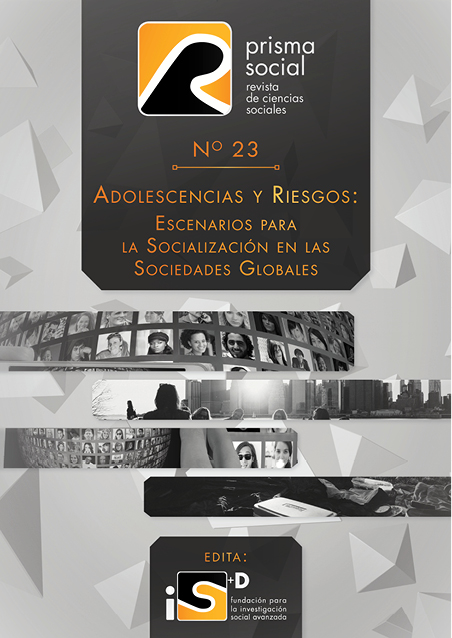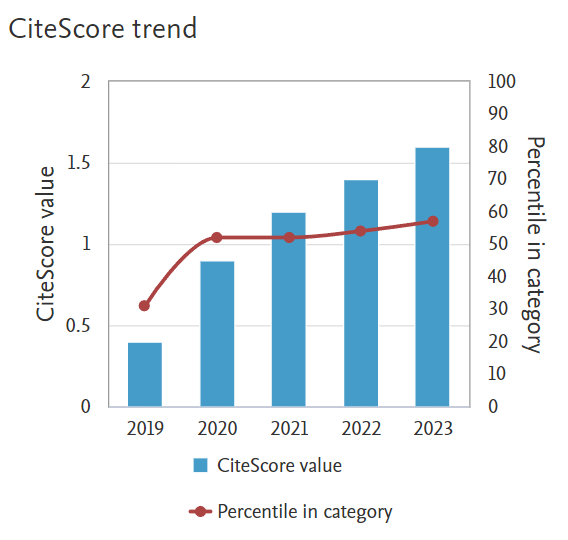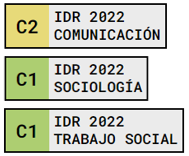Prevalencia, motivaciones y respuestas afectivas del ciberacoso en la red social anónima Curious Cat
Keywords:
Ciberagresión, Cibervictimización, Red social, Anonimato, Prevalencia, Curious Cat, Motivación, Respuesta AfectivaAbstract
El presente trabajo pretende realizar un análisis de la prevalencia, las motivaciones y las respuestas afectivas en los/as usuarios/as de la red social emergente Curious Cat. Para ello, se realizó el análisis de una muestra no probabilística incidental de 1025 usuarios/as. Se aplicaron versiones adaptadas de los cuestionarios CYBA y CYVIC. Los resultados mostraron que la mayoría de las agresiones era de carácter verbal, y que tenía lugar principalmente por motivos cotidianos. Las amenazas físicas o los ataques debidos a cuestiones de género o identidad sexual resultaron ser muy inferiores. Las víctimas mostraron una tendencia a sentirse indiferentes ante los ataques recibidos, mientras que los/as agresores/as justificaron su conducta amparándose en la hipotética justicia que impartían con sus actos.
Downloads
References
Agamben, G. (2000). Lo que queda de Auschwitz: el archivo y el testigo. Homo Sacer III. Valencia: Pre-textos.
Álvarez-García, D., Barreiro-Collazo, A., & Núñez, J.-C. (2017). Ciberagresión entre adolescentes: prevalencia y diferencias de género. Revista Comunicar, XXV(50), 89–97.
Álvarez-García, D., Barreiro-Collazo, A., Núñez, J. C., & Dobarro, A. (2016). Validity and reliability of the Cyber-aggression Questionnaire for Adolescents (CYBA). European Journal of Psychology Applied to Legal Context, 8(2), 69–77. http://doi.org/10.1016/j.ejpal.2016.02.003
Arendt, H. (1999). Eichmann en Jerusalén. Barcelona: Editorial Lumen.
Barlett, C., Chamberlin, K., & Witkower, Z. (2017). Predicting cyberbullying perpetration in emerging adults: A theoretical test of the Barlett Gentile Cyberbullying Model. Aggressive Behavior, 43(2), 147–154. http://doi.org/10.1002/ab.21670
Barlett, C. P., Gentile, D. A., & Chew, C. (2016). Predicting cyberbullying from anonymity. Psychology of Popular Media Culture, 5(2), 171–180. http://doi.org/10.1037/ppm0000055
Bauman, Z. (1997). Modernidad y Holocausto. Madrid: Sequitur.
Becker, J. C., Kraus, M. W., & Rheinschmidt-Same, M. (2017). Cultural Expressions of Social Class and Their Implications for Group-Related Beliefs and Behaviors. Journal of Social Issues, 73(1), 158–174. http://doi.org/10.1111/josi.12209
Brochado, S., Soares, S., & Fraga, S. (2016). A Scoping Review on Studies of Cyberbullying Prevalence Among Adolescents. Trauma, Violence, & Abuse, 152483801664166. http://doi.org/10.1177/1524838016641668
Duncan, S. H., & Brandeis, L. D. (2015). Cyberbullying and restorative justice. Cyberbullying Across the Globe: Gender, Family, and Mental Health, 1, 239–257.
http://doi.org/10.1007/978-3-319-25552-1_12
Gahagan, K., Vaterlaus, J. M., & Frost, L. R. (2016). College student cyberbullying on social networking sites: Conceptualization, prevalence, and perceived bystander responsibility. Computers in Human Behavior, 55, 1097–1105. http://doi.org/10.1016/j.chb.2015.11.019
Garaigordobil, M. (2015). Ciberbullying en adolescentes y jóvenes del País Vasco: Cambios con la edad. Anales de Psicología, 31(3), 1069–1076. http://doi.org/10.6018/analesps.31.3.179151
Garaigordobil Landazabal, M., Martínez Valderrey, V., & Machimbarrena, J. M. (2017). Intervención en el bullying y cyberbullying: Evaluación del caso Martín. Revista de Psicología Clínica Con Niños Y Adolescentes, 4(1), 25–32.
Gilden, A. (2013). Cyberbullying and the innocence narrative. Harvard Civil Rights-Civil Liberties Law Review, 48, 357–407.
Giménez, A. M., Maquilón, J. J., & Arnaiz, P. (2015). Usos problemáticos y agresivos de las TIC por parte de adolescentes implicados en cyberbullying Problematic and aggressive use of ICT in adolescents involved in cyberbullying. Rie, 33(2), 335–351. http://doi.org/10.6018/rie.33.2.199841
Hilberg, R. (1992). Perpetrators, victims and bystanders: The Jewish Catastrophe, 1933-1945. New York: Harper Collins.
Hinduja, S., & Patchin, J. W. (2008). Cyberbullying: An exploratory analysis of factors related to offending and victimization. Deviant Behavior, 29(2), 129–156. http://doi.org/10.1080/01639620701457816
Hinduja, S., & Patchin, J. W. (2017). Cultivating youth resilience to prevent bullying and cyberbullying victimization. Child Abuse and Neglect, 73, 51–62. http://doi.org/10.1016/j.chiabu.2017.09.010
Hosseinmardi, H., Han, R., Lv, Q., Mishra, S., & Ghasemianlangroodi, A. (2014). Towards understanding cyberbullying behavior in a semi-anonymous social network. ASONAM 2014 - Proceedings of the 2014 IEEE/ACM International Conference on Advances in Social Networks Analysis and Mining, 1, 244–252. http://doi.org/10.1109/ASONAM.2014.6921591
Igartua, J. J. (2006). Métodos cuantitativos de investigación en comunicación. Barcelona: Bosch.
König, A., Gollwitzer, M., & Steffgen, G. (2010). Cyberbullying as an Act of Revenge?. Australian Journal of Guidance and Counselling, 20(2), 210–224. http://doi.org/10.1375/ajgc.20.2.210
Lévinas, E. (1993). Entre nosotros. Ensayos para pensar en otro. Valencia: Pre-Textos.
Liu, H. (2007). Social network profiles as taste performances. Journal of Computer-Mediated Communication, 13(1), 252–275. http://doi.org/10.1111/j.1083-6101.2007.00395.x
McInroy, L. B., & Mishna, F. (2017). Cyberbullying on Online Gaming Platforms for Children and Youth. Child and Adolescent Social Work Journal, 1, 1–11. http://doi.org/10.1007/s10560-017-0498-0
Miller, C. (2006). Cyber harassment: Its forms and perpetrators. Law Enforcement Technology, 33(4), 26.
Ortega Ruiz, R., & Córdoba Alcaide, F. (2017). El Modelo Construir la Convivencia para prevenir el acoso y el ciberacoso escolar. Innovación Educativa, (27), 19–32.
Pardo, J. L. (2004). La Regla del juego : sobre la dificultad de aprender filosofía. Barcelona: Galaxia Gutenberg.
Pendergrass, W. S., & Public, A. (2014). Cyberbullied to Death: An Analysis of Victims Taken from Recent Events. Issues in Information Systems, 15(I), 132–140.
Pieschl, S., Kourteva, P., & Stauf, L. (2017). Challenges in the Evaluation of Cyberbullying Prevention - Insights from Two Case Studies. International Journal of Developmental Sciences, 11(1–2), 45–54. http://doi.org/10.3233/DEV-160209
Rafferty, R., & Vander Ven, T. (2014). “I Hate Everything About You”: A Qualitative Examination of Cyberbullying and On-Line Aggression in a College Sample. Deviant Behavior, 35(5), 364–377. http://doi.org/10.1080/01639625.2013.849171
Rodríguez Serrano, A. (2015). Espejos en Auschwitz. Apuntes sobre cine y holocausto. Santander: Shangrila.
Sari, S. V., & Camadan, F. (2016). The new face of violence tendency: Cyber bullying perpetrators and their victims. Computers in Human Behavior, 59, 317–326. http://doi.org/10.1016/j.chb.2016.02.027
Shultz, E., Heilman, R., & Hart, K. J. (2014). Cyber-bullying: An exploration of bystander behavior and motivation. Cyberpsychology, 8(4). http://doi.org/10.5817/CP2014-4-3
Wang, G., Wang, B., Wang, T., Nika, A., Zheng, H., & Zhao, B. Y. (2014). Whispers in the dark: analysis of an anonymous social network. Imc, 12, 137–150. http://doi.org/10.1145/2663716.2663728
Wang, X., Yang, L., Yang, J., Wang, P., & Lei, L. (2017). Trait anger and cyberbullying among young adults: A moderated mediation model of moral disengagement and moral identity. Computers in Human Behavior, 73, 519–526. http://doi.org/10.1016/j.chb.2017.03.073
Žižek, S. (2010). El acoso de las fantasías. Madrid: Siglo XXI de España.
Downloads
Published
How to Cite
Issue
Section
License
Those authors who publish in this journal accept the following terms:
-
Authors retain copyright.
-
Authors transfer to the journal the right of first publication. The journal also owns the publishing rights.
-
All published contents are governed by an Attribution-NoDerivatives 4.0 International License.
Access the informative version and legal text of the license. By virtue of this, third parties are allowed to use what is published as long as they mention the authorship of the work and the first publication in this journal. If you transform the material, you may not distribute the modified work. -
Authors may make other independent and additional contractual arrangements for non-exclusive distribution of the version of the article published in this journal (e.g., inclusion in an institutional repository or publication in a book) as long as they clearly indicate that the work was first published in this journal.
- Authors are allowed and recommended to publish their work on the Internet (for example on institutional and personal websites), following the publication of, and referencing the journal, as this could lead to constructive exchanges and a more extensive and quick circulation of published works (see The Effect of Open Access).


















